Poisoning land and lives
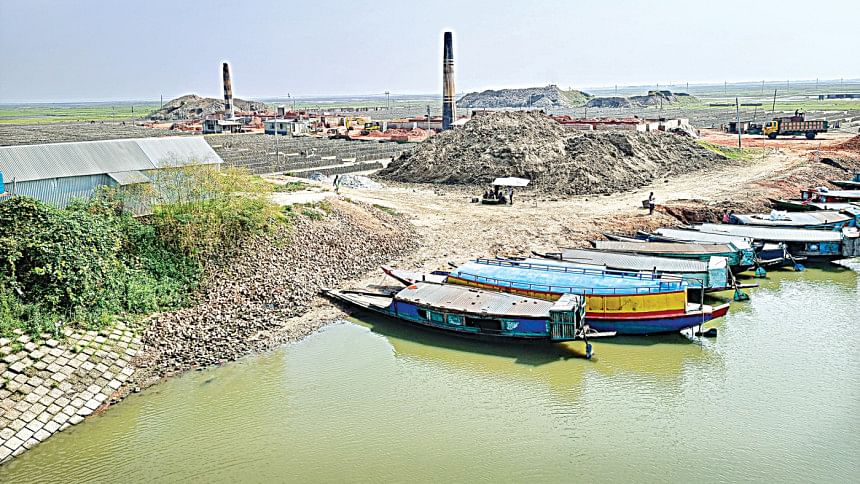
Afarchan Begum, a 60-year-old resident of Balarampur village in Brahmanbaria's Bijoynagar upazila, is grappling with respiratory issues attributed to toxic black smoke from nearby brick kilns.
During a recent conversation, she revealed that two kilns -- Banoful and Digital Brick Field -- are located adjacent to her village. The chimney of Banoful Brick Kiln is clearly visible from the village's only government primary school. The emissions from these kilns are ruining their homes and the environment.
The dust from the ash generated by brick burning accumulates on their houses, stunting the growth of local vegetation. "Mango blossoms wither, green coconuts fall prematurely, and crops such as lemons and perennial chillies no longer give any yield," Afarchan said.
Even livestock and poultry are frequently affected by the polluted air. During the peak brick-burning season, fine dust particles carried by the wind settle on residents' skin and belongings, many other villagers added.
Afarchan's plight resonates with hundreds of farmers across the villages of Shoshoi, Budhanti, Islampur, Shahbazpur, Chandura, and Rampur in Bijoynagar upazila.
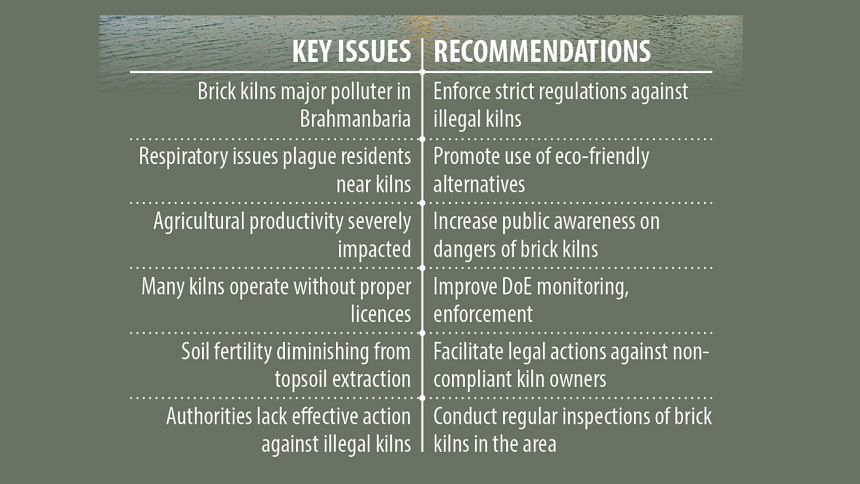
Despite the severe consequences, brick burning has been a persistent issue in the area for almost two decades, often occurring without proper permissions.
Alarmingly, authorities have taken no effective action against the kilns, which continue to operate with impunity, alleged locals.
Locals report that some kiln owners openly admit to "managing" local administration to continue their operations without interference.
According to the Department of Environment (DoE), Brahmanbaria has 177 brick kilns, with 110 operating without licences. Many of these kilns are situated in prohibited zones near schools, markets, farmlands, residential areas, and riverbanks.
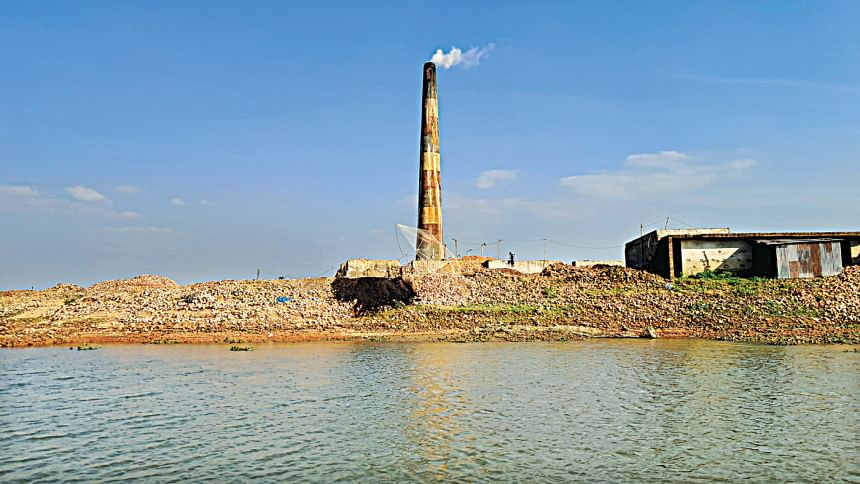
Rakibul Hasan, an inspector with the DoE, said owners of 18 brick kilns in the district are continuing production by filing writ petitions in the High Court.
"Despite being illegal, they have resorted to this tactic to exploit the legal system," he said.
Consequently, the DoE finds itself powerless to act against these kilns, even though they lack proper clearance, he added.
During a recent visit to Nazirabari village in Bijoynagar upazila, this correspondent witnessed that vast fields once used for cultivating paddy, mustard, and winter vegetables have now been overtaken by brick kilns.
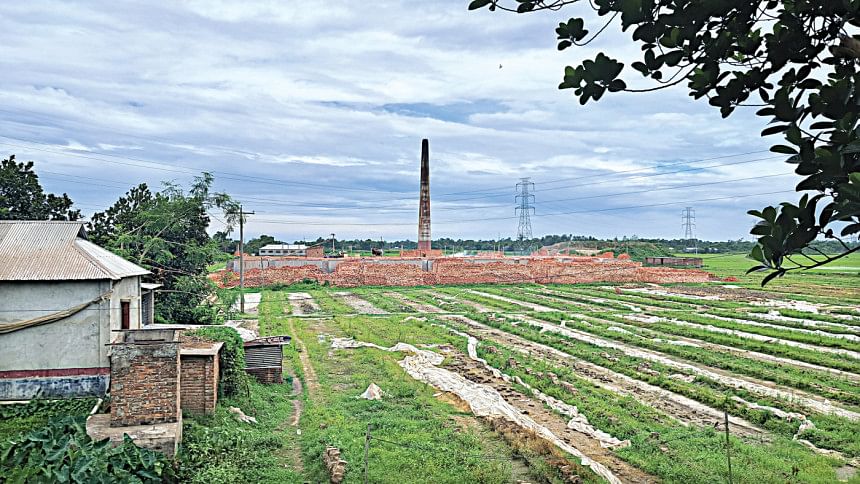
Two kilns -- Messrs Digital Bricks and Banoful Brick -- have been set up side by side, occupying the entire field near a paved road built by the Local Government Engineering Department (LGED) a few years ago.
While visiting Rajabariakandi village in Shahbazpur union under Sarail upazila, multiple brick kilns on both the north and south sides were observed, leaving residents struggling with respiratory illnesses.
Last year, approximately 50 acres of Boro paddy fields in Lopara village under Chunta union were destroyed due to toxic gases from nearby brick kilns, said locals.
Field visits to Suhilpur and Bakail villages under Sadar upazila, as well as various kilns in Sarail and Bijoynagar upazila, revealed that most of these unauthorised kilns are built on fertile farmland.
Alarmingly, many are located close to residential areas and within just 500 metres of educational institutions. Despite the existing ban, at least 10 brick kilns have been constructed along the Dhaka-Sylhet highway, said officials.
The Jinan Brick Field, located along the Dhaka-Sylhet highway in Chandura village under Bijoynagar upazila, is surrounded by agricultural land on three sides. Its short chimney emits black smoke during this season, scorching the upper leaves of adjacent rice plants.
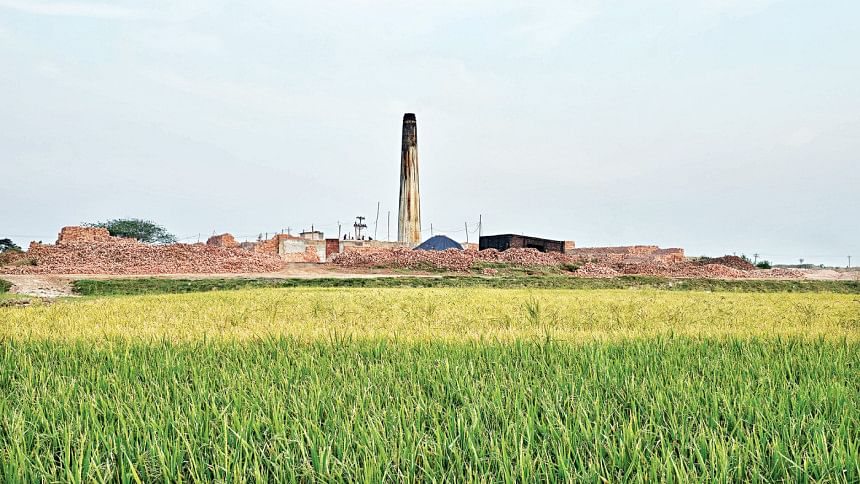
Local residents complain that the transport of bricks and raw materials by trucks stirs up thick dust clouds, damaging crops and covering nearby homes in layers of fine particles. Almost all kilns emit hazardous black smoke, severely impacting plant life -- rice plants' upper leaves wither, mango blossoms shrivel, and trees' foliage burns.
Despite the severe environmental and economic consequences, local residents feel powerless against the influential kiln owners, who wield financial and political clout. While a few have attempted to resist, they often find themselves unable to confront the brick kiln owners' money and muscle power.
Sachhu Miah, the owner of Banoful Bricks, which was established in 2009 in Nazirabari village, defended his operations.
He claimed, "We are operating the kiln by coordinating with the Department of Environment, union parishad, deputy commissioner, and upazila nirbahi officer offices."
"Although there have been discussions about making blocks as an alternative to bricks, it is not possible. Therefore, as long as there is public demand, we will continue to produce bricks," he said.
Meanwhile, environmental activists argue that despite years of legal violations, the DoE and district administration have failed to take significant action against brick kiln owners. They alleged that before each brick-making season, kiln owners engage in large-scale financial transactions to "manage" the authorities.
Sohel Rana Bhuiyan, a member of Tori Bangladesh -- Social Movement for River and Nature Protection --said, "How can so many illegal brick kilns operate in a single district? Immediate legal action must be taken against these environmentally hazardous kilns. If no action is taken, the government officials involved must be held accountable. No illegal brick kiln should be allowed to operate at the cost of our environment."
Md Nasir Mia, member secretary of the Brahmanbaria district unit of the National Committee for the Protection of Oil, Gas, Mineral Resources, Power, and Ports, said, "The fertility of agricultural land is concentrated in the top 12 to 20 inches of soil. When this upper layer is removed, the land becomes barren. A group of middlemen exploits impoverished farmers, luring them with incentives to sell topsoil.
"As a result, two to three feet of soil is excavated from farmlands for brick-making. This unregulated extraction not only reduces soil fertility but also severely disrupts agricultural production."
Experts also suggested adopting alternatives, such as the environment-friendly "hollow blocks", that will greatly reduce the dependence on bricks.
They said when the demand is down, these kilns will have little incentive to carry on with their devastating activity.
Therefore, what the authorities must do is increase the production of eco-friendly blocks while improving vigilance to prevent brick kilns from ravaging lands for topsoil.
Contacted, Azizul Haque, general secretary of the Brahmanbaria Brick Manufacturers' Association, defended the industry, stating, "Brick kilns are allowed to use soil for brick-making until 2025. After that, using soil for bricks will be prohibited. If kilns are abruptly shut down, people will suffer, and development will be hindered."
"The administration should adopt a balanced approach -- being lenient towards kilns causing minimal environmental harm while taking gradual action over the next three years against those causing significant damage," he added.
Brahmanbaria Deputy Commissioner Mohammad Didarul Alam assured that the list of illegal brick kilns is being updated.
"Multiple operations have already been conducted to shut down these kilns, and some operations are still ongoing. Instructions have been given to various upazilas to take legal actions, including fines and other penalties, by conducting mobile courts against these illegal brick kilns according to the rules," he said.

 For all latest news, follow The Daily Star's Google News channel.
For all latest news, follow The Daily Star's Google News channel. 







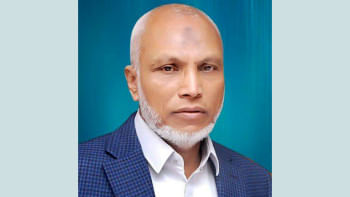
Comments